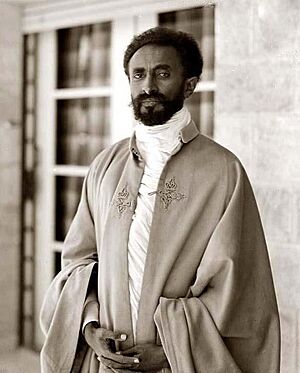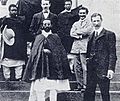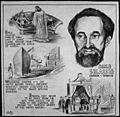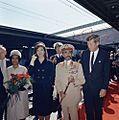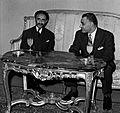Haile Selassie I of Ethiopia facts for kids
Haile Selassie I (born July 23, 1892 – died August 26, 1975) was a very important leader. He was the last Emperor of Ethiopia. Many people, especially those in the Rastafari movement, see him as a special religious figure. They believe he is God in human form and call him by his earlier name, Ras Tafari.
Contents
Early Life and Rise to Power
Haile Selassie was born Tafari Makonnen. He became the governor of a place called Sidamo in 1907. Later, in 1911, he became the governor of Harar province. He gained many supporters there.
At that time, a ruler named Lij Iyasu was the regent, meaning he ruled for the empress. Tafari and Iyasu had an agreement: Tafari wouldn't try to take Iyasu's power, and Iyasu wouldn't remove Tafari as governor. But Iyasu broke this promise by trying to remove Tafari. Because the agreement was broken, Tafari felt he no longer had to follow it. He then worked to remove Iyasu from power.
Becoming Emperor of Ethiopia
Because Lij Iyasu had made some unpopular choices, the nobles decided to replace him. On September 27, 1916, they made Empress Zauditu the new ruler and Tafari became her regent. This meant he was in charge of Ethiopia's government.
In 1928, Tafari was given the title of negus, which means king. Then, on November 2, 1930, he was crowned Emperor. His full title was "Haile Selassie I, King of Kings of Ethiopia, Conquering Lion of the Tribe of Judah, Elect of God."
His coronation was a huge event that got attention all over the world. News about it appeared in magazines like TIME. This made people curious, especially on the faraway island of Jamaica. Because of his grand titles, many people there, who would later form the Rastafari movement, began to believe he was a divine leader and a symbol of freedom for Black people.
Challenges and Return to Power
In 1936, Mussolini's Italy invaded Ethiopia. Haile Selassie had to leave his country. He gave a powerful speech at the League of Nations, an international organization, asking the world to help stop the Italians. Sadly, other countries did not act to stop the invasion.
During World War Two, with the help of the British, Haile Selassie was able to return to Ethiopia in 1941. He worked hard to rebuild his country.
Later Years and Legacy
In 1963, Emperor Haile Selassie played a key role in starting the Organisation of African Unity (OAU). This important group aimed to bring African nations together. Its main office was in Addis Ababa, Ethiopia's capital.
In 1966, he visited Jamaica. There, he met with members of the Rastafarian community, who had long looked up to him.
On September 12, 1974, Haile Selassie was overthrown by a military group. They announced he died the following August from natural causes. However, later information suggested he was killed. Many Rastafarians still believe he is alive.
Images for kids
-
Haile Selassie with President Lyndon B. Johnson at the White House
-
Cover of Time magazine, 3 November 1930
-
When the struggle to resist Italy appeared doomed, Haile Selassie traveled to the rock-hewn churches of Lalibela for fasting and prayer.
-
The Emperor arrives in Jerusalem. May 1936
-
Newspaper illustration drawn by Charles H. Alston for the U.S. Office of War Information Domestic Operations Branch News Bureau, 1943
-
Meeting with Crown Prince Akihito in 1955
-
Haile Selassie with Brigadier Daniel Sandford (left) and Colonel Wingate (right) in Dambacha Fort, after its capture, 15 April 1941
-
Haile Selassie with U.S. President John F. Kennedy, October 1963
-
Haile Selassie with President Gamal Abdel Nasser of Egypt in Addis Ababa for the Organisation of African Unity summit, 1963.
See also
 In Spanish: Haile Selassie para niños
In Spanish: Haile Selassie para niños


